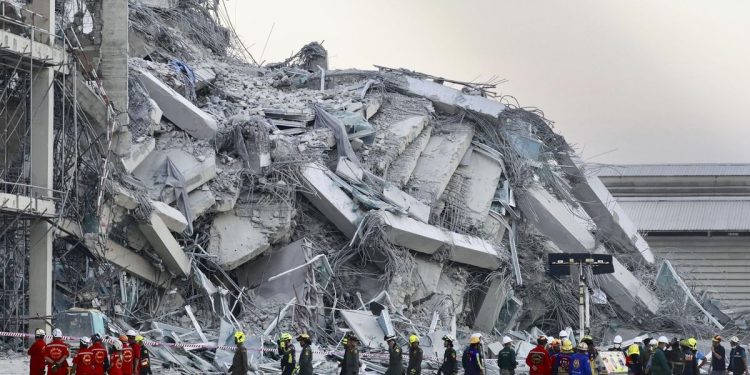Bangkok – The global belt and Chinese road initiative is under intense control after a single structure in the Thai capital collapsed in the earthquake last week: a 30 -storey building under construction by the Communist country.
The wreckage of the incomplete skyscraper revealed what some analysts said was proof of lower quality construction. It was a part of the global infrastructure initiative which is a key element in Beijing’s sweet diplomacy strategy.
The steel strengthening stems exposed in the collapse seem to have broken under the tension of the earthquake. The building, that a Chinese company and a Thai construction company built for the audit office of the state of Thailand, was reduced to a huge bunch of rubble.
Fifteen deaths were confirmed and 72 workers are missing.
“I watched several clips in the building collapse from different angles,” said a Thai Prime Minister amazed Paetongtarn Shinawatra. “According to my experience in the construction industry, I have never seen a problem like this.
“We must investigate in depth because a large part of the budget has been allocated, and the deadline for completion has been extended,” said Paetongtarn.
The investigation started with a bizarre and disturbing view.
Two days after the earthquake, four Chinese men were captured on the video by entering as many documents related to the construction they could transport and run from the rubble site.
Police arrested them, interviewed and released. The Chinese embassy in Bangkok and the powerful interior ministry of Thailand, who supervises the police, met to discuss the collapse of the skyscraper, but their talks were not made public.
The image of China in Thailand is crucial for Beijing, who has been unofficially done in Washington for decades to influence diplomacy, politics, the economy and the soldiers of Bangkok.
China has favored economic ties with Bangkok by education, investment, tourism and financial assistance.
Investigators extracted two types of steel strengthening bars, called barrack bars, debris from the collapsed skyscraper. These bars were supposed to support the building when they were locked up in cement pillars.
After the earthquake, the Iron and Steel Institute of Thailand would have discovered that the chemical composition, the mass and the resistance to the mass and the stress of the reinforcement bars seemed to fail its tests.
The photographs displayed by the ministry and the local media showed a brand name released on a steel arrival bar, dug from the wreck linked to a Chinese acid.
Some Thai have expressed anxiety about the growing influence of Beijing on the development of the country.
The sophisticated tourism industry of Thailand, the condominium market and the construction of condominium and the construction of several billion dollars, insurance companies and other sectors have taken success since the earthquake.
Economists have estimated that the Southeast Asian Nation is undergoing a loss of more than a billion dollars of the earthquake. The Public Works Department said on Wednesday that at least 30 high -rise buildings in Bangkok had been damaged and deemed uninhabitable.
The public and Thai media criticize government institutions responsible for inspecting construction contracts, design plans and building materials so as not to be able or do not want to correct problems in the condemned skills.
Many Thai people noted, with dark irony, that the only building to collapse in Bangkok was to be the new house in the state audit office.
The government agency is responsible for preventing fudged contracts and questionable questionable projects. On Wednesday, the Facebook page of the state audit office was inaccessible after strong criticism and corruption charges.
The construction contract was a joint project between the Chinese government’s Group Engineering of the Chinese government and the development of the Italian-Thai-based in Thailand, the largest construction company in Thailand and one of the largest in Southeast Asia.
China Railway No. 10 Engineering Group is part of China Railway Engineering Corp., or CREC, one of the largest engineering and construction companies in the world.
CREC and the railway n ° 10 are documents from the Belt and Road initiative, an international development and financial expansion project in Beijing. CREC projects for the initiative include the impressive the Railways of Beijing-Shanghai and Qinghai-Tibet of China and, in East Africa, the Mombasa-Nairobi railway through Kenya.
CREC is a company belonging to the Communist Chinese government and has carried out other projects in Thailand, including railways for a link in what will eventually become a high -speed line connecting Beijing and Singapore via Bangkok. He also helped build one of the underground metropolitan lines in Bangkok and bid for others.
The Ministry of Commerce, the division of the repression of economic crime of the Royal police and the income department would have opened surveys on a dozen other projects in Thailand, possibly linked to CREC and China Railway n ° 10.
Before the earthquake, CREC proudly announced the Bangkok Sao skyscraper construction contract as the “first high-rise building for the office abroad”.
Philip J. Cunningham, researcher of Asian policy in the media, said that the CREC website had deleted photos, quotes and other pages related to the Sao building, including the previous announcement of CREC, after the earthquake.


